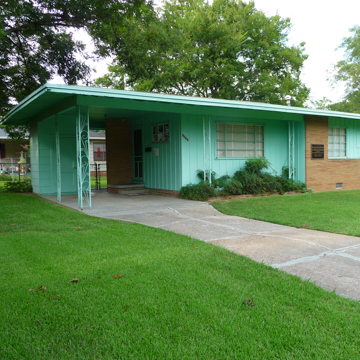You are here
Medgar Evers Home Museum
Medgar Evers had this ranch house built for his family soon after becoming the Mississippi field secretary for the NAACP. Its modest size belies its nationally significant place in American history. Typical of middle-class American housing in the post–World War II period, the one-story wood-frame house has brick and wood siding, a low hipped roof, steel casement windows, decorative metal posts, and a carport. The one-street Elray subdivision in which it stands was developed by Winston J. Thompson and built by contractor LeRoy Burnett, African American World War II veterans, for Jackson's growing Black middle class. The subdivision adjoined a white subdivision on Missouri Street.
A native of Decatur, Evers worked as an insurance salesman in the Mississippi Delta after graduation from Alcorn State College and witnessed the deep poverty and oppression of many Black Mississippians. Moved to political action, he became Mississippi's first state field secretary for the NAACP in 1955. With the civil rights movement heating up, threats became a daily part of the Evers family's life. When his house was built, Evers eliminated the standard front entrance as a security measure, leaving the only entrance through the carport door. In the early 1960s the house was shot into twice, and a firebomb was thrown into the carport. On the night of June 11, 1963, after watching a televised speech by President Kennedy about the need for civil rights legislation, Evers returned home and was shot in the back in his carport, the bullet traveling through the front wall and into the kitchen. Evers was taken to University Medical Center but died before he could be treated. A rifle was later found abandoned in a vacant lot on Missouri Street. Here architecture and events shaped history: if the carport had been on the opposite side of the house, Evers would have been less exposed to the vacant lot.
After two hung juries in the 1960s, suspect Byron de la Beckwith, a member of the White Citizens Council, was retried in 1994 and found guilty of murder. Evers’s wife, Myrlie, and their three children moved to California in 1967, and sold the house to Tougaloo College in 1993. Restored, the house is the state's first house museum dedicated to the civil rights movement. The house is furnished to the period Medgar and Myrlie lived here, and one room has displays telling the story of their lives.
Writing Credits
If SAH Archipedia has been useful to you, please consider supporting it.
SAH Archipedia tells the story of the United States through its buildings, landscapes, and cities. This freely available resource empowers the public with authoritative knowledge that deepens their understanding and appreciation of the built environment. But the Society of Architectural Historians, which created SAH Archipedia with University of Virginia Press, needs your support to maintain the high-caliber research, writing, photography, cartography, editing, design, and programming that make SAH Archipedia a trusted online resource available to all who value the history of place, heritage tourism, and learning.














